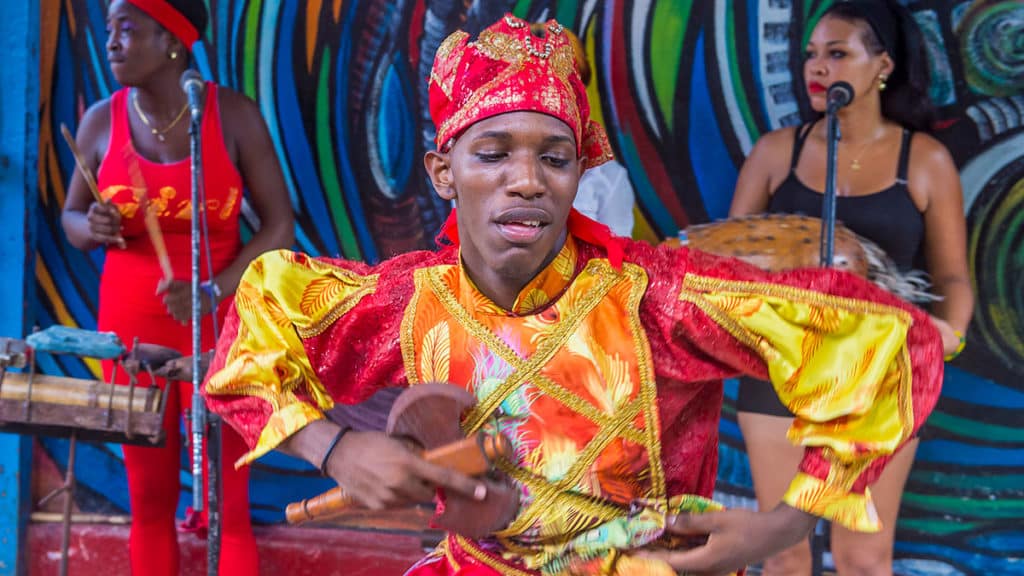Changó (also Xangô, Sàngó or Santa Barbara) is the Yoruba orisha of music, drumming, and dancing, but also of thunder, lightning, and war. These days, we focus on the fun side of his character.
[Editor’s Note: These are oral traditions that vary in families and communities up and down the West African coast. They vary even more in the Caribbean and South America depending on where our African ancestors came from and who they mixed with. We are part of the tradition, but weren’t raised in it, so these are just our impressions. Only a Babalawo priest or Iyaláwo priestess can explain the tradition in its fullness.]
Changó, Xangô, Sàngó
He is Changó in Spanish, Xangô in Brazilian Portuguese, and Sàngó in Nigerian Yoruba.
Changó is a fierce warrior, but also a great drummer, handsome dancer, and a passionate ladies’ man. He is feared for his bad temper, but musicians love him. Changó represents the manly man characteristics of power, passion, and virility, but women can also be Changó as Santa Barbara.
Changó’s Feast Day
His feast day is December 4. It’s an important festival day in Cuba.
Symbols of Changó

Changó’s colors are red and white. His number is 6. His day of the week is Friday. The 4th is his day of the month. He owns the sacred batá drums.
Dancers for Changó wear red pants and a red shirt with white trim, wear a crown, and dance with a double-headed ax.
His sacred food is a stew of okra with shrimp, onion and palm oil. In New Orleans, that would be gumbo. Wynton Marsalis of Jazz at Lincoln Center has said that jazz is like gumbo. Wynton was referring to the mix of traditions, but he might have also been referring to Changó. Our first exposure was at Jazz at Lincoln Center when we covered Cuban jazz legend Chucho Váldez with Wynton Marsalis and the Jazz at Lincoln Center Orchestra and Pedrito Martínez.
Drumming, dancing and singing can be for fun or part of a healing or religious ceremony. Specific drum patterns and movements are only used in ceremonies. They have been done the same way since the beginning of time.
Here is a Baile Shango Lasaro Ros on YouTube. It looks like Changó is dancing with his wife Oshun who is also an orisha.
The name of Brooklyn-based charanga Los Hacheros (the Axemen) and cover of their second album Bambulaye (Chulo/Daptone Records, 2016) are both references to Changó.
Syncretized with Santa Barbara
In the Americas, Changó is syncretized (blending two cultures) with Santa Barbara.
It’s often said that Africans in the colonial Americas preserved their heritage faith by concealing it inside veneration of the slavers’ Catholic saints. But there is another way to look at syncretization. The Africans recognized the similarities between faiths. The colonizer priests were either too ignorant, or worse saw the similarities and denied them.
When Ismael Miranda sang with Larry Harlow’s orchestra in Abran Paso (Make Way, 1972)…
Abran paso ~ Make way
Cosa buena, abreme paso mamá ~ Good things, open to me
Que yo vengo bien caliente ~ I come hot and ready
con Santa Barbara a mi lado ~ with Saint Barbara at my side
con su cepa y con su espada ~ with her force and her sword
para aliviarle de todo mal ~ to relieve you of all evil
…he was singing in code that he comes with the power of Changó to heal. You can watch the young Miranda singing with the Orquesta Harlow in The Bronx in 1971, in Ismael Miranda Con La Fania Abran Paso Pelicula Our Latin Thing 1971 on YouTube.
[Editor’s Note: I have no idea why this has entered my life so powerfully, but my last three months in New York City, I slept in a room filled with bronze Ife heads from Nigeria and Benin, and when I first came to Puerto Rico just after, I listened to this song constantly. I had no idea what it meant, but know I do.]
The African drum is a healing instrument. Stand close to the drummers and you will know it.
In Latin America, references to Santa Barbara are code for Changó. Once you understand the code, you see this everywhere in the Caribbean.
He was a Real Person who became a God
Some orishas are purely spiritual. Others were historical figures who were deified.
Changó was the third king of Oyó, a Yoruba state on the border of Benin and Nigeria. His seven-year reign was marked by fighting and conquest, but he made the Oyó Empire rich. He had several wives as was customary, but his wife Oshún also became an orisha.
The reign of Changó ended when his palace was struck by lightning. After that, the Oyó Empire declined and in the 1800s, many of his people were sold into slavery by the neighboring Fulani and Fon (Benin). That is how many Yorubans ended up in the Americas.
Yorubans have a reputation as good politicians and administrators. The Yoruba religion became the dominant African religion in Cuba and Recife, Brazil. From Cuba it spread across the Caribbean.
Àṣẹ
